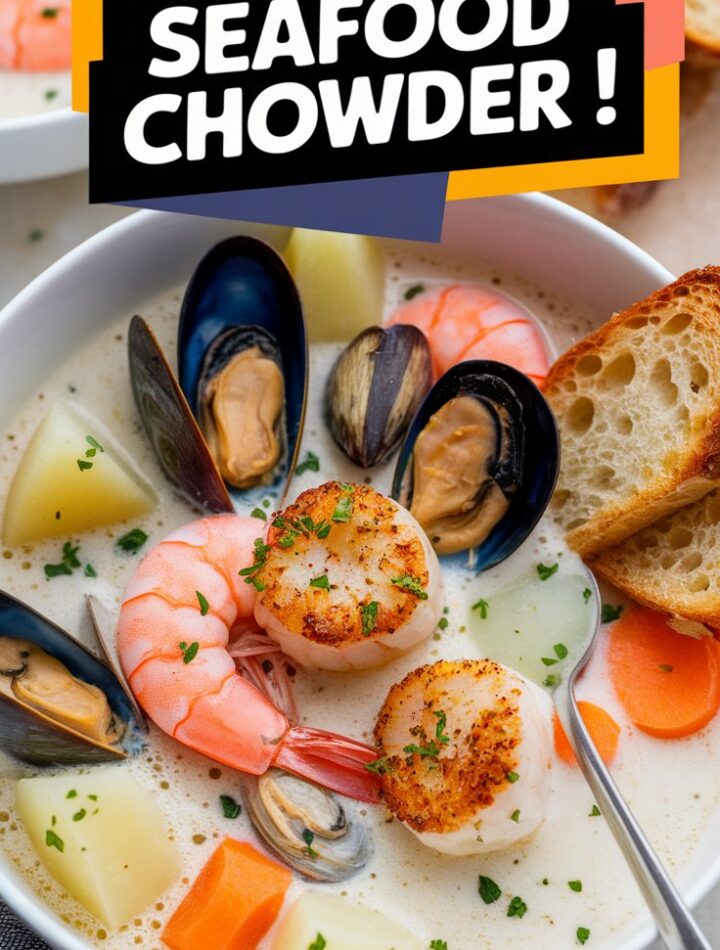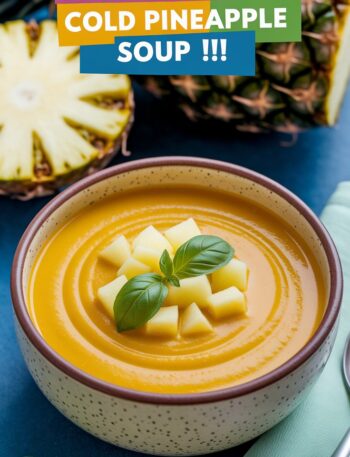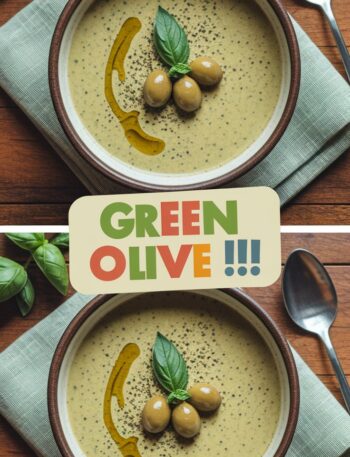Seafood chowder is one of those timeless dishes that instantly makes you feel at home. With its rich, velvety broth, tender chunks of seafood, hearty potatoes, and sweet pops of corn, this creamy seafood chowder delivers comfort in every spoonful. Whether you’re serving it on a chilly evening, entertaining guests, or meal-prepping for the week, this recipe is versatile, satisfying, and surprisingly easy to make.
In this complete guide, you’ll discover everything you need to know about creamy seafood chowder—from its origins and variations to expert cooking tips, ingredient substitutions, storage solutions, and serving suggestions. By the end, you’ll not only have a perfect chowder recipe but also the knowledge to customize it to your taste and make it your own.
1. What is Creamy Seafood Chowder?
Chowder is a thick, hearty soup traditionally made with milk or cream, potatoes, onions, and seafood or clams. Its roots trace back to coastal communities in New England, where fishermen would combine the day’s catch with readily available ingredients.
Unlike lighter seafood soups or broths, chowder is defined by its creamy, velvety texture. The cream balances the briny seafood flavors, while potatoes and vegetables add body and substance. Over the years, chowder recipes have evolved—ranging from classic New England clam chowder to corn chowder, fish chowder, and even tomato-based Manhattan chowder.
Our recipe celebrates the best of tradition but also leaves room for creativity, allowing you to tailor it based on your preferences and the seafood available in your kitchen.
2. Why You’ll Love This Recipe
- One-Pot Meal: Everything cooks in a single pot, making cleanup easy.
- Hearty and Comforting: Potatoes, corn, and cream create a filling, cozy dish.
- Customizable: Works with shrimp, scallops, clams, crab, or your favorite white fish.
- Crowd-Pleaser: Perfect for family dinners, potlucks, or dinner parties.
- Meal Prep Friendly: Flavors deepen when reheated, making it great for next-day meals.
3. Key Ingredients (and How to Choose Them)
🧈 Butter
The base for sautéing vegetables. Use unsalted butter to better control saltiness.
🧅 Aromatics (Onion, Celery, Garlic)
These create the flavor foundation. Dice finely so they melt seamlessly into the chowder.
🥔 Potatoes
Russet potatoes give creaminess when broken down, while Yukon Golds hold shape well. A mix of both is ideal.
🌽 Corn
Fresh kernels in summer, frozen in winter—both work perfectly. They add sweetness and texture.
🐟 Mixed Seafood
Shrimp, scallops, clams, mussels, crab, or chunks of white fish (like cod, halibut, or haddock). Always add seafood at the end of cooking to keep it tender.
🥛 Heavy Cream + Stock
Cream provides richness, while stock adds depth. Use seafood stock for authentic flavor; chicken or vegetable stock works in a pinch.
🌿 Herbs & Spices
Fresh thyme, bay leaf, salt, and black pepper bring balance. Finish with parsley for freshness.
4. Step-by-Step Instructions
Ingredients
- 4 tbsp unsalted butter
- 1 medium onion, finely chopped
- 2 celery ribs, finely diced
- 3 cloves garlic, minced
- 3 tbsp all-purpose flour
- 4 cups seafood stock (or chicken stock)
- 3 medium potatoes, peeled and diced (Yukon Gold preferred)
- 2 cups corn kernels (fresh or frozen)
- 1 bay leaf
- 1 tsp fresh thyme (or ½ tsp dried)
- 1 lb mixed seafood (shrimp, scallops, white fish, or clams)
- 1 cup heavy cream
- ½ cup whole milk
- Salt and freshly ground black pepper, to taste
- 2 tbsp fresh parsley, chopped (for garnish)
Instructions
- Sauté the aromatics:
In a large pot or Dutch oven, melt butter over medium heat. Add onion and celery, cooking until soft (about 5 minutes). Add garlic and cook 1 more minute. - Make the roux:
Sprinkle flour over vegetables and stir well. Cook 2 minutes to remove the raw flour taste. - Build the base:
Slowly whisk in seafood stock, ensuring no lumps form. Add potatoes, bay leaf, and thyme. Simmer 15 minutes, until potatoes are tender. - Add vegetables and seafood:
Stir in corn and seafood. Simmer gently for 5–7 minutes until seafood is cooked through. - Finish with cream:
Reduce heat to low. Stir in heavy cream and milk. Warm through but do not boil. Season with salt and pepper. - Serve:
Ladle into bowls, garnish with parsley, and serve hot with crusty bread or oyster crackers.
5. Expert Tips for the Best Chowder
- Don’t overcook seafood: Add it last and simmer gently until opaque and tender.
- Avoid curdling: Never let the chowder boil after adding cream. Keep heat low.
- Thicker texture: Mash some of the potatoes in the pot before adding seafood.
- Flavor boost: Add a splash of dry white wine when sautéing vegetables.
- Smoky depth: Stir in crisp bacon or smoked salmon for a different twist.
6. Ingredient Substitutions and Variations
- Dairy-Free: Replace cream with coconut milk for a lighter, dairy-free chowder.
- Low-Calorie: Use half-and-half instead of heavy cream.
- Gluten-Free: Replace flour with cornstarch slurry.
- Seafood Swap: Try mussels, crab meat, or lobster for luxury.
- Veggie Additions: Carrots, bell peppers, or leeks for extra nutrition and color.
7. Serving Suggestions and Pairings
- Crusty sourdough bread or garlic breadsticks
- Oyster crackers for crunch
- A crisp green salad with vinaigrette
- White wine (Chardonnay or Sauvignon Blanc)
- Chowder in bread bowls for an elevated presentation
8. Nutritional Information (per serving, approx. 6 servings)
- Calories: 420
- Protein: 28g
- Carbohydrates: 32g
- Fat: 22g
- Fiber: 4g
- Sodium: 880mg
9. Storage and Reheating
- Refrigerator: Store in airtight containers up to 3 days.
- Freezer: Freeze up to 1 month (best without cream; add cream after reheating).
- Reheating: Warm on stovetop over low heat, stirring often. Do not boil.
10. Make-Ahead and Freezer Tips
- Cook base (without seafood and cream) ahead of time. Refrigerate up to 2 days.
- When ready to serve, reheat base, add seafood, then finish with cream.
- This method ensures seafood stays tender and fresh.
11. Frequently Asked Questions
Q1. Can I use frozen seafood?
Yes, thaw completely and pat dry before adding.
Q2. What seafood works best?
Firm white fish, shrimp, scallops, clams, mussels, or crab.
Q3. How can I thicken my chowder?
Mash some potatoes, or use a cornstarch slurry.
Q4. Can I make it dairy-free?
Yes, substitute coconut milk or almond cream.
Q5. Can I freeze creamy seafood chowder?
Yes, but freeze before adding cream for best results. Add cream after reheating.
Q6. What goes well with seafood chowder?
Bread, crackers, salad, or roasted vegetables.
Q7. How do I prevent rubbery seafood?
Add seafood at the very end and cook only until opaque.
12. Conclusion
Creamy Seafood Chowder is more than just a soup—it’s a bowl of warmth, comfort, and coastal flavor. With its creamy broth, tender seafood, and hearty vegetables, this dish is a family favorite you’ll return to again and again. The beauty of chowder is its flexibility: you can make it luxurious with lobster, simple with white fish, or dairy-free with coconut milk.
Whether enjoyed on a snowy evening, served at a dinner party, or made ahead for weekday meals, this chowder will quickly become part of your recipe rotation. Pair it with crusty bread, share it with loved ones, and savor the rich flavors that make seafood chowder a timeless classic.



